The Cable Squat Row (With Rope Attachment) is a compound exercise that targets the muscles of the back, shoulders, and arms, while also engaging the lower body.
How to perform
To perform the Cable Squat Row (With Rope Attachment) exercise, follow these steps:1. Position yourself in front of a cable machine with a rope attachment on the low pulley.
2. Grab the ends of the rope attachment with an overhand grip, palms facing each other, and step back a few feet to create tension on the cable.
3. Stand with your feet shoulder-width apart and toes slightly turned out. Engage your core and maintain a straight spine throughout the exercise.
4. Squat down by bending your knees and hips, as if you are sitting back into a chair. Keep your chest up and your weight in your heels.
5. As you reach the bottom of the squat, pull the rope attachment towards your lower ribcage by squeezing your shoulder blades together and bending your elbows. Keep your elbows close to your body and focus on engaging your back muscles.
6. Pause at the top of the row, then slowly extend your arms to return to the starting position. Keep tension on the cable throughout the movement.
7. Complete the desired number of reps, then carefully stand up and release the rope attachment.
8. Remember to maintain proper form and control throughout the exercise to ensure optimal muscle engagement and prevent injury.
Overall, the Cable Squat Row (With Rope Attachment) is a challenging exercise that can help improve strength and muscular endurance in the back, shoulders, and arms. It is important to start with a lighter weight and focus on mastering proper form before increasing the resistance.
Equipment required
Cable
Cable equipment consists of adjustable pulleys attached to weight stacks that allow for resistance training. This equipment is commonly used for strength training exercises that target various muscle groups in the body, such as chest, back, arms, and legs. Cable equipment provides a versatile and functional way to perform exercises that mimic real-life movements, improving muscle endurance, stability, and coordination.


